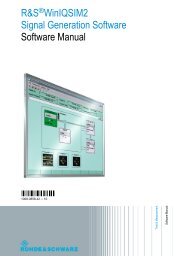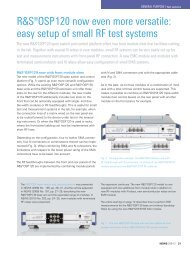News from Rohde&Schwarz - Rohde & Schwarz
News from Rohde&Schwarz - Rohde & Schwarz
News from Rohde&Schwarz - Rohde & Schwarz
Create successful ePaper yourself
Turn your PDF publications into a flip-book with our unique Google optimized e-Paper software.
Application notes<br />
Settings on QAM modulator<br />
SMIQ with option SMIQ-B10<br />
(after preset)<br />
Frequency:<br />
Frequency: 36.000 MHz<br />
Level:<br />
Amplitude: – 7dBm<br />
Digital Modulation:<br />
State: ON<br />
Modulation:<br />
Type: 256QAM – 8b/symb<br />
Symbol Rate: 5 000 000 symb/s<br />
Digital Modulation:<br />
Source:<br />
Source: PRBS<br />
PRBS Length: 2 15 –1<br />
Filter:<br />
Filter Type: SQR COS<br />
Filter Parameter: 0.15<br />
Coding: Phase Diff.<br />
Settings on TV Test Receiver EFA<br />
(after preset)<br />
Mode:<br />
QAM Analyzer/Demod<br />
Input: IF (36 MHz)<br />
Status:<br />
Order of QAM: 256<br />
SAW Filter Bandwidth: OFF<br />
Symbol Rate:<br />
Symbol Rate Value: 5 MSPS<br />
Special Function:<br />
Min BER Integr.: BER EXT<br />
MPEG Data Output:<br />
Par. MPEG Data PLL: ON<br />
IQ Inversion: Normal<br />
FIG 2 Settings required on Signal Generator<br />
SMIQ for synchronizing arbitrary 256QAM<br />
signal with TV Test Receiver EFA<br />
FIG 3 (top right)<br />
Constellation diagram for 256QAM<br />
FIG 4 (bottom right)<br />
Parameters calculated for 256QAM<br />
However, to synchronize the QAM<br />
signal correctly, it is necessary<br />
that all decision fields be occupied<br />
with an equally frequent<br />
number of symbols.<br />
Both of these problems are of a basic,<br />
ie physical nature, and therefore<br />
apply to all measurements of QAM<br />
signals irrespective of the measuring<br />
instrument used.<br />
How to do it<br />
In our example, Signal Generator<br />
SMIQ [2] <strong>from</strong> <strong>Rohde</strong> & <strong>Schwarz</strong> with<br />
option SMIQ-B10 supplies the QAM<br />
signal, which is then evaluated by TV<br />
Test Receiver EFA. FIG 2 shows the<br />
QAM modulator settings required for<br />
correct transmission of a QAM signal<br />
and for analysis by the test receiver.<br />
SMIQ internally generates I/Q signals<br />
for any standard required and supplies<br />
the modulated signal at its<br />
RF output.<br />
The above settings are selected so that<br />
all physical and technical requirements<br />
necessary for synchronizing all QAM<br />
signals up to 256QAM (FIG 3 and 4)<br />
are met.<br />
Summary<br />
TV Test Receiver EFA is an ideal choice<br />
for the analysis and evaluation of<br />
arbitrary QAM signals, even for signals<br />
containing no synchronization<br />
information at all. To ensure correct<br />
transmission of such signals, only a<br />
few physical relationships have to be<br />
taken into account, for example the<br />
length of the random sequence in<br />
repetitive data sequences. Differential<br />
coding must also be selected on the<br />
generator. Excellent results can be<br />
achieved in this way even for relatively<br />
short sequences, for example PRBS<br />
2 15 –1.<br />
Christoph Balz<br />
Reader service card 164/07<br />
REFERENCES<br />
[1] Christoph Balz; Ernst Polz; Walter Fischer:<br />
TV Test Receiver Family EFA – Top fit for<br />
digital television. <strong>News</strong> <strong>from</strong> <strong>Rohde</strong> &<br />
<strong>Schwarz</strong> (1996) No. 152, pp 17–19<br />
[2] Johann Klier: Signal Generator SMIQ – Highquality<br />
digital modulation up to 3.3 GHz.<br />
<strong>News</strong> <strong>from</strong> <strong>Rohde</strong> & <strong>Schwarz</strong> (1997) No.<br />
154, pp 4– 6<br />
<strong>News</strong> <strong>from</strong> <strong>Rohde</strong> & <strong>Schwarz</strong> Number 164 (1999/IV) 23

















